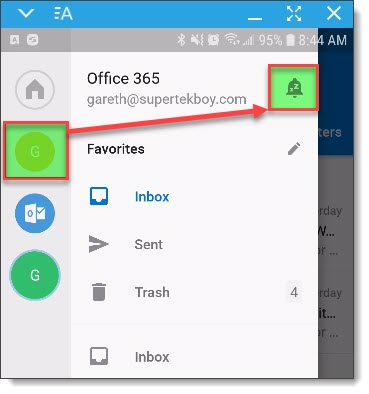The Task module of Outlook isn’t one of the prettiest or most modern parts of Outlook and probably also one of the lesser used modules by most.
Outlook can’t send after upgrading to Windows 10; Setting the Sent Items folder for IMAP accounts in Outlook 2013 or Outlook 2016; Inbox Repair Tool (scanpst.exe) Do not automatically mark as read; Links do not open: This operation has been cancelled due to restrictions; More popular tips. Create tasks and to-do list items in Outlook for Mac to help you stay organized. Select the Tasks icon, and then select New Task. Add a subject, date, and priority. Select the Reminder checkbox if you'd like to set a reminder.
Creating and managing tasks in Outlook can sometimes be a task of its own and there isn’t really a way to manage your Tasks when using a smartphone or tablet. Until now…
Have you already used the Microsoft To-Do app?
Very brief background of Microsoft To Do
Microsoft To Do has been developed by the same team that developed the popular Wunderlist app. Microsoft acquired Wunderlist when it bought the company 6Wunderkinder in June 2015.
Since then, Wunderlist has been redesigned to work in tandem with various Office 365 services and integration with Outlook, Exchange Online and Outlook.com and released as a new application called Microsoft To Do in April 2017.
Microsoft To Do strives to be an intelligent task management app that makes it easy to plan and manage your day.
Download the app and Outlook integration
To get started with Microsoft To Do, download the app for your platform or use it in a browser;
To login, use your Microsoft Account or your Workplace Account (Office 365 for Business). Microsoft To Do will show all your tasks that you have currently stored within the Tasks folder of your Outlook.com or Exchange Online mailbox.
If you haven’t added the Outlook.com mailbox for your Microsoft Account to Outlook yet, you can do so by following these instructions.
Some things to note when getting started;
- Your Outlook Tasks folder is also called Tasks in Microsoft To Do.
- When you create a new Task in Microsoft To Do, it will be added as a Task in Outlook and vice-versa.
- When you create a new “New list” in Microsoft To Do, it will be added as a Task folder in Outlook.
- Each day, your “My Day” in Microsoft To Do will be empty and can be filled with tasks of your To Do list(s).
- You can quickly plan to do’s for your day by selecting “My Day” in Microsoft To Do and then click on the lightbulb icon in the top right corner.
When using Windows 10, you may not even want to use the Tasks module in Outlook anymore at all!
Integration with Office 365 for Business Exchange Online
As mentioned, Microsoft To Do can also integrate with the Tasks folder of your Exchange Online mailbox. However, when trying to login with your Workplace Account, you can get the following login error;
To Do is disabled
Sorry! Microsoft To Do is not enabled for your organization. Please contact your IT admin about getting access or use the option below to learn more.
Administrators can enable/disable the Microsoft To Do app license on a per user basis. Microsoft To Do is included in practically all Office 365 suites licenses for work or school accounts which include Exchange Online such as;
- Business Essentials
- Business Premium
- Microsoft 365 Firstline F1
- Enterprise Firstline F1 & F2
- Enterprise E1-E5
- Secure Productive Business
- Secure Productive Enterprise E3 & E5
- Education E1-E5
- Education A1-A5
- Microsoft 365 A3-A5
Standalone Exchange Online plans are currently not supported and neither are tenants on sovereign/independent clouds such as from GoDaddy or Office 365 Germany.
Future development and feature suggestions
Many new features are already in the planning for future releases.
You can upvote already existing suggestions or post new ones at the official UserVoice page of Microsoft To Do.
Outlook To Do Lists
I’ve been using Outlook since forever and I remember that I used to be able to create Desktop shortcuts to Outlook folders simply by dragging a folder out of Outlook and onto my Desktop (or any other folder in Explorer). This allowed me to quickly go to or open Outlook in a specific folder.
When I try do this now, my mouse pointer turns into a blocked shield.
Is it still possible to create Desktop shortcuts to specific Outlook folders in another way?
These type of shortcuts are xnk-files and support for creating these shortcuts was officially dropped in Outlook 2007 but existing xnk-shortcuts could then be still revived via a Registry key. Outlook 2010 and later no longer provide support for xnk-files at all.
However, you can still create a Desktop shortcut to a specific folder in Outlook by using the /select command line switch.
Creating a shortcut with the /select command line switch
The example below shows you how to create a Desktop shortcut to the Calendar folder in Outlook.
- Create a new Outlook shortcut:
- Windows 7
Type outlook in the Search field of the Start Menu. Right click on it and choose; Send To-> Desktop (create shortcut) - Windows 8 and Windows 10
Typeoutlook.exein the Search field or Start Menu. Right click on it and choose: Open file location. In the File Explorer window that opens, right click onOUTLOOK.EXEand choose; Send To-> Desktop (create shortcut).
For full instructions and alternative methods see: Creating an Outlook Desktop shortcut in Windows 8 or Windows 10
- Windows 7
- Right-click the shortcut you just created, and from the shortcut menu click Properties.
- On the Shortcut tab, locate the Target box. It contains the path for Outlook.exe.
- Press the SPACEBAR once to type a space after the path, and then type;
/select outlook:calendar- For Outlook 2016 (MSI) 32-bit on a 64-bit version of Windows, the full command should now look like this;
'C:Program Files (x86)Microsoft OfficeOffice16Outlook.exe' /select outlook:calendar - For an Outlook 2016 (C2R), Outlook 2019 and Microsoft 365 installation of Outlook 64-bit, the full command should now look like this;
'C:Program FilesMicrosoft OfficerootOffice16Outlook.exe' /select outlook:calendar
- For Outlook 2016 (MSI) 32-bit on a 64-bit version of Windows, the full command should now look like this;
- Click OK.
- On the desktop, double-click the Outlook shortcut you created and it should now open the Calendar folder in Outlook.
Creating a custom shortcut with the command line to start
Outlook in the Calendar folder.
How to specify a folder
Outlook To-do Calendar
Specifying a folder quite easy, but there are a couple of things to note:
- If the folder is in the main mailbox, simply type the name.
Example:/select outlook:calendar - If the folder contains spaces, contain it in quotes.
Example:/select 'outlook:Sent Items' - If the folder is a subfolder, separate by a forward slash (/).
Example:/select outlook:Inbox/Newsletters - If the folder is in a different mailbox, you’ll need to precede the folder name with 2 forward slashes and specify the name of that mailbox as shown in the Navigation Pane.
Example:/select outlook://Archive/Inbox


If you want to create a Desktop shortcut to your corporate Public Folders, you can combine the above set of rules in the following way;
/select 'outlook://Public Folders - youraddress@company.com/All Public Folders'
Extra tip:
If you do not want to open the folder in a new Outlook window, you can add the /recycle switch as well. The Microsoft 365 example would then become;'C:Program FilesMicrosoft OfficerootOffice16Outlook.exe' /select outlook:calendar /recycle
Changing the shortcut icon
When you create the Desktop shortcut, it will have the default Outlook icon. You can change the icon to match it with the folder type it points to in the following way;
Outlook To Do
- Right click on the Desktop shortcut and choose Properties.
- Select the Shortcut tab.
- Press the button: Change Icon…
- Select the icon of choice.
- Press OK.
Select a different icon for your custom Outlook shortcut.
Note:
For more command line switches to use with Outlook see the guide: Command line switches for Outlook 365, 2019, 2016, 2013, 2010 and previous
